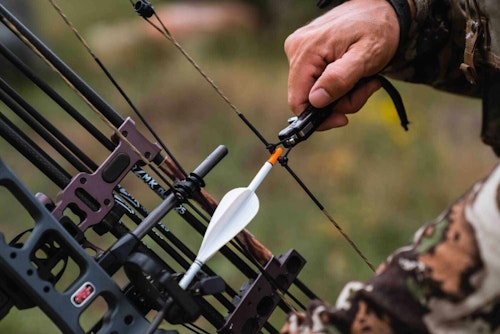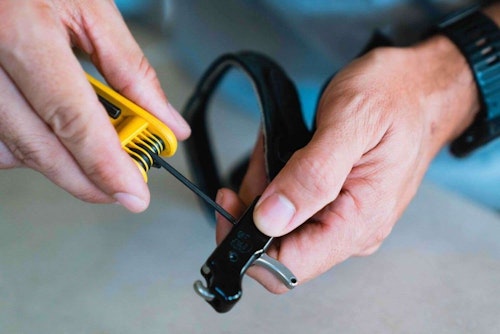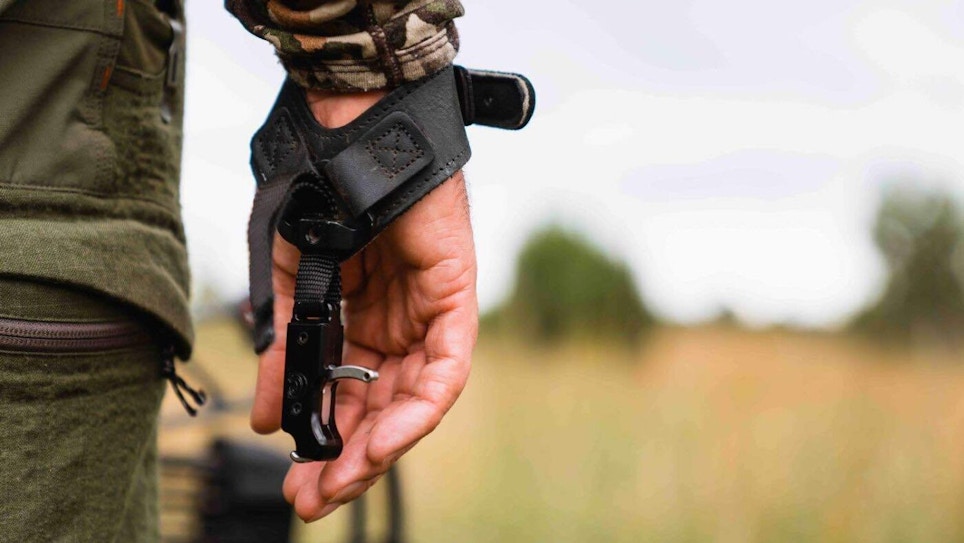I was about 12 years old and my dad had just brought home the first compound bow I had ever seen in person. My knowledge of bows and arrows at the time didn’t extend past the point of fond memories I’d made with toy bows and suction cup arrows. So, I was surprised when I saw Dad wearing a weird strap on his hand with a trigger to shoot the bow. It was the classic index-style release that we all know and love. Soon after, he let me try it out for myself. I was amazed, and it’s where my love of bowhunting really started — right there in that backyard with an old bow and a trusty index-style release.
Index-style releases are the standard in release aids for bowhunting. Due to their self-explanatory design and seamless transition from shooting a gun, it’s usually the first release new bowhunters gravitate toward. As popular as they are though, they do get some flack in the name of bringing to light bad habits such as target panic. Because of that, there are a fair number of folks who have drifted away from them. Sad, but true.
Since my time as a youngster in the backyard, I truly believe this release is misunderstood. In light of that, I want to break them down — the good, the bad, and the best. Toward the end of my article, I’ll dive into how to properly execute a shot with one. Fact: With the right technique and mental game, index-style releases are just as accurate and deadly as any release out there. They are the perfect blend of practicality and lethality.

The Good
Let’s kick this shindig off by going over some of the positives that come with using an index-style release for bowhunting. They all have one thing in common, which is “easy.”
*Easy To Use: The first thing that comes to mind is the ease of use. Like I mentioned previously, these releases offer a seamless transition from shooting a gun, due to the trigger system. Because of that, most anyone can pick up a bow and operate an index release right away without too much thought. That lack of a learning curve translates fantastic right into the field, too, when it’s time to actually start bowhunting.
When the heat gets turned up and an animal is within bow range, our thoughts can cripple us. Too much thinking can lead to poor decisions and lost opportunities. I actually lost an opportunity on a world-class black bear at only 10 yards due to a more complicated mechanical release design. Simple is usually better, and the index release bleeds simple.
*Easy to Command: Bowhunting is a from 0-60 mph type of deal. Things can happen quick, and our moments to harness success are limited. Because of that, bowhunting can also go from 60-0 mph. What I’m getting at here is capitalizing on an opportunity when it presents itself, because it can disappear as quickly as it appears.
Being that an index-style release operates off of a trigger system, it performs great in these somewhat hectic situations where time is of the essence. The hunter can make the shot go when they need to just by simply pulling the trigger. This means that one doesn’t have to sit there and wait for the shot to break if the situation doesn’t call for it.
I know that goes against the grain of achieving the surprise shot that reigns supreme in the archery world, but this is the bowhunting world. Time waits for nobody and that elk might be in your one shooting lane for only a few seconds. I’m not encouraging reckless shooting by any means here. It’s calculated efficiency. Another win for the index-style release.
*Easy to NOT Lose: Finally, what is quite obvious, but definitely one of the best things about index-style releases — the wrist strap. I can’t tell you how many times me or someone I knew set something down on the ground in the field and forgot to pick it back up. That’s fine if it happens to be something like a set of gloves. It could be a complete hunt-ender should it be your release, though. There’s no worry of this happening with an index-style release, and you can still use both of your hands while wearing it.
I usually have my release strapped on my wrist most of the day and have no issues completing daily tasks out there. And when it’s not on my wrist, it’s strapped to either my bow or my backpack. Because of this feature, you almost have to try and lose an index-style release.
The Bad
As much of a fan I am of index releases, there are some drawbacks to them. In short, all of them are a result of not being taught how to properly execute a shot with one.
*They’re Too Easy: Remember how I said that these were easy to use? While that is a positive, it’s also a negative. Let me elaborate. Because they are so easy to use and most can figure it out on their own, more than a few folks will grab one of these off of the shelf, take it home and just start using it. Now, I know that sounds pretty uneventful, but there’s one issue: They never took the time to actually be taught how to operate an index-style release.
Because of this, bad habits form fairly easily. Trust me, I was one of them. The tough part is, you don’t know what you don’t know. So, ingraining these bad habits into your routine is something that you’ll likely not even notice on your own. This is where a good archery coach can help immensely. I’m all for DIY, but in this case, it’s better to learn correctly the first time to set yourself up for success later on.
*Hard to Be Consistent: Accuracy in archery is all about consistency on our part. One needs to be able to do the same thing every time for the best results downrange. Index-style release aids can make achieving that consistency quite difficult. Note that I said “can” there. Because with the right technique, they are incredibly consistent. The problem is, due to the ease of use I just explained, most don’t learn how to properly use one.
In most cases, archers inject too much movement into their shot execution. An example of this would be the trigger finger moving to hit the trigger. This is something most people do, and most cannot repeat that same movement time and time again. There are too many variables at play that don’t cater to the consistency we want. Things such as where the trigger sits on your finger, how much pressure is being put on the trigger, and finally how that trigger is being engaged. These things need to be seamless and repeatable. When they’re not, the result is often frustration, over-aiming, overthinking, and the worst of all . . . target panic.
*Target Panic: I’ll put money down that 9 out of 10 folks who pick up an index-style release aid, and don’t properly learn how to use one, end up getting target panic. It’s a more than common occurrence, and one that can eat away at one’s mental game once they bend the limbs back.
For me, it was the touchiness of my trigger. Like many bowhunters out there, I had set my index trigger very light — like hair trigger light. Because of that, I soon grew this anxiety about the release going off. It caused me to flinch, and sometimes I’d completely miss the target at 20 yards. Beating the mental demon of target panic took me years. And it was all because I never learned how to truly use an index release.

The Best
Despite some of the potential drawbacks of index-style releases, I’m a huge fan of them for bowhunting. In my opinion, they are the BEST release for hitting the hills with a bow and arrow.
The two best things about an index style release for bowhunting are accuracy and practicality. With the right know-how, these releases offer up a perfect blend of the two, resulting in one deadly system. Having it strapped right to your wrist eliminates losing the release and puts it always at the ready, which for hunting is a massive benefit. It’s also not a complicated release, which puts it more in reach for beginners and lessens the chance of having a brain meltdown in the field. And with the right technique, you won’t be sacrificing accuracy in the least. An index release is as accurate as they come.
Final Thoughts
I may be much older now than that kid in the backyard, but my thoughts on the index-style release hold true. There are some things in life that will always remain timeless. Sure, they may have their ebbs and flows, but their position is a constant one. In the bowhunting world, the index-style release falls into that timeless category. It just works, and works well for that matter.
Successful bowhunting is all about putting as many odds in your favor as you can. The accuracy and practicality that the index release provides equals the lethality that bowhunters want. Period.


Sidebar: How To Properly Use an Index-Style Release
After all of this talk about the importance of knowing how to properly execute a shot with an index-style release, it wouldn’t be right of me to not go over how to do so. Before going into this, I want to stress that there isn’t necessarily a “right way” to all of this. Bowhunting is your own canvas and you hold the paint brush. However, I will say I believe there to be a “best way” to learn. Absorb that and continue on with your painting.
- The Right Fit: In order for the technique I’m going to cover to work properly, the first thing one needs to do is make sure the release fits right. The wrist strap should be fairly snug around your wrist, but I’m mainly referring to the trigger position. At rest, the top of my release will sit where my fingers meet my palm. This fitting is much easier achieved with the web connect styles of index releases. They allow one to get that release nice and short, which is how you want it.
- A Heavy Trigger Is Better: Once the release length is set correctly, it’s time to set the trigger tension. Heavier is better. It’s not jumpy and can be controlled much easier. Set the trigger heavy enough to where you’re not afraid to put your finger on it, apply some tension, and not fear it going off. That is crucial for the next step to work right.
- The Full Hook: Come to full draw and completely wrap your index finger around the trigger at your second joint. This will put a full hook around the trigger. I’ll actually touch the bottom of my release with the tip of my index finger to make sure I’m doing it right. It also serves as another anchor point.
- Relax and Pull: Now, instead of moving your index finger to set off the trigger, you’ll begin to relax your release hand and slowly pull against the back wall of your bow by squeezing your shoulder blades. Your draw arm elbow should begin moving rearward slightly. While doing this, it’s important to keep your index finger hook rigid. This will cause the hook to essentially run right into the trigger.
- Never Stop Aiming: One of the keys to accuracy is to never stop aiming throughout this entire process. Burn a hole in that spot you want to hit while waiting for the shot to break. Some might question this method in a potentially intense hunting situation with a small shooting window. All one would have to do there is to speed up the process. That’s it.
Photos by Josh Kirchner






